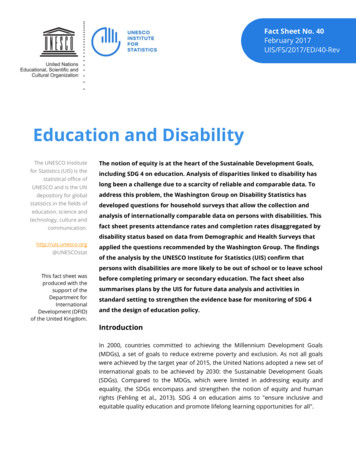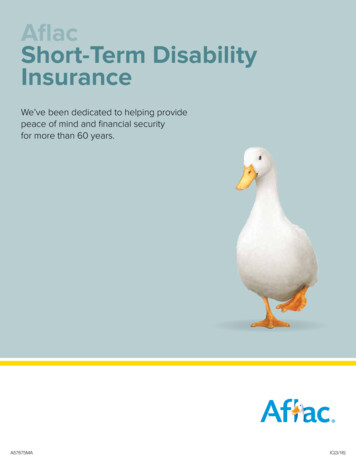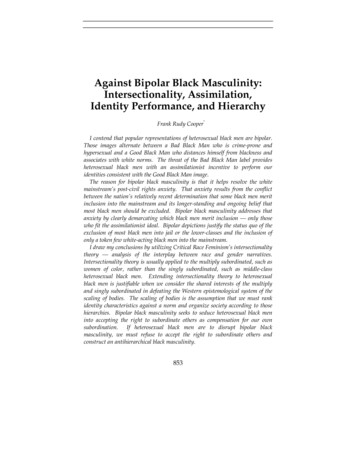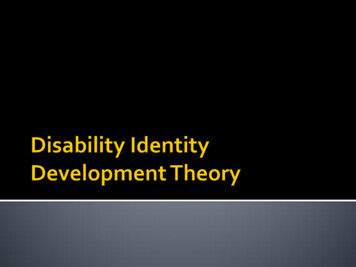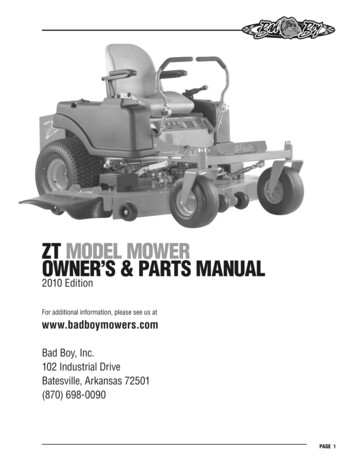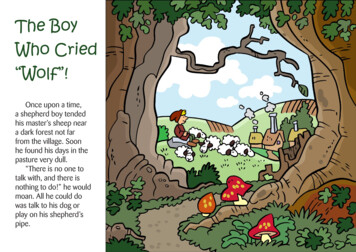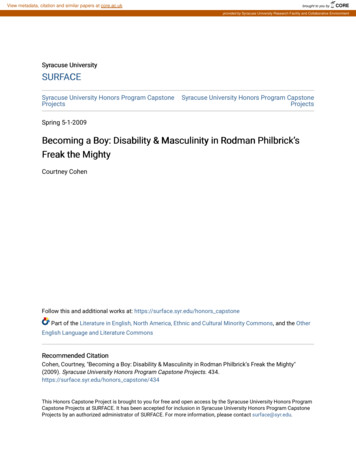
Transcription
View metadata, citation and similar papers at core.ac.ukbrought to you byCOREprovided by Syracuse University Research Facility and Collaborative EnvironmentSyracuse UniversitySURFACESyracuse University Honors Program CapstoneProjectsSyracuse University Honors Program CapstoneProjectsSpring 5-1-2009Becoming a Boy: Disability & Masculinity in Rodman Philbrick’sFreak the MightyCourtney CohenFollow this and additional works at: https://surface.syr.edu/honors capstonePart of the Literature in English, North America, Ethnic and Cultural Minority Commons, and the OtherEnglish Language and Literature CommonsRecommended CitationCohen, Courtney, "Becoming a Boy: Disability & Masculinity in Rodman Philbrick’s Freak the Mighty"(2009). Syracuse University Honors Program Capstone Projects. 434.https://surface.syr.edu/honors capstone/434This Honors Capstone Project is brought to you for free and open access by the Syracuse University Honors ProgramCapstone Projects at SURFACE. It has been accepted for inclusion in Syracuse University Honors Program CapstoneProjects by an authorized administrator of SURFACE. For more information, please contact surface@syr.edu.
Becoming a Boy: Disability & Masculinityin Rodman Philbrick’s Freak the MightyA Capstone Project Submitted in Partial Fulfillment of theRequirements of the Renée Crown University HonorsProgram at Syracuse UniversityCourtney CohenCandidate for B.A. Degreeand Renée Crown University HonorsMay 2009Honors Capstone Project in EnglishCapstone Project Advisor:Claudia KlaverHonors Reader:Christopher BellHonors Director:Samuel GorovitzDate: April 22, 2009
AbstractMy Capstone thesis is a discussion of the various representations ofdisability in Rodman Philbrick’s children’s book and the film it was madeinto. In analyzing the characters, relationships between the characters andvernacular used within the text, I came to the conclusion that certain parts ofthe book, including the inclusion of not one, but two characters withimpairments as main characters, serve to engage the book in a complexdiscourse with various concepts of disability and masculinity.In order to place Philbrick’s text within a larger discourse of disabilitystudies, I analyze it with regard to theories of disability and its representation.I discuss the use of particular words and phrases to describe Max and Kevin.Although in some instances, the use of negative terms to describe people withdisabilities such as “freak” or “cripple” can be empowering and intended toreclaim and redefine these words, the terms can also be misinterpreted andunderstood as the proper words to use when talking about people withdisabilities. Specifically children, the target audience for the book may notrealize that these terms are the incorrect ones to use.In the next part of my paper, I explain the theory of the notion ofdisability as “incomplete,” and how the combination of Max and Kevin into asingular entity “Freak the Mighty” complicates this idea. When Max andKevin come together to form Freak the Mighty, they come to embody theimage of the ideal, consisting of a sound mind and a sound body thatnonetheless remain distinct, which perpetuates the Cartesian theory of duality.This unification of Max and Kevin into Freak the Mighty leads to theiracceptance by their peers and adults in their lives, which emphasizes the ideathat the boys are not worthy of acceptance and praise on their own and areseen only as a “whole” person when they are together, which calls attention tothe social construction of the abled/disabled binary.The next section of my paper focuses on the heavy representation ofthe supercrip stereotype in the book. The supercrip is a person with adisability who “overcomes” his or her impairment to achieve normality, whichcan be critically problematic because disability is not something that needs tobe overcome. In the end of the book, Max succeeds in overcoming hislearning disability and becomes a writer, while Kevin, who is incapable ofovercoming his disability because of its physical manifestations, dies. The fateof both boys enforce the image of the supercrip and the importance placed onovercoming disability. In the penultimate section of my paper I discuss howstereotypes and constructions of masculinity are enforced through Max andKevin’s characters. In the same way that he is able to overcome his disability,Max grows into a more traditionally masculine character in the end, whileKevin, who cannot represent a stereotypical man physically, dies before hecan grow into a man. The final section of my paper deals with the adaptationof Freak the Mighty into a film. I discuss what changes were made and whatimportance those changes have in terms of the representation of disabilityboth within and outside the text.
Table of ContentsCapstone Body . 1Introduction . . .1History of Characters with Disabilities in Literature . . 2Resignifying Epithets . . 4Freak the Mighty and the Theory of Disability as Incomplete.9Max and Kevin as Supercrips . . . 19Issues of Masculinity in The Mighty . .29Adapting Freak the Mighty for the Silver Screen . .37Freak the Mighty becomes The Mighty: The Problem of Casting. .45Conclusion and Further Study . .49Works Cited . . .51Works Consulted . .53Written Capstone Summary .54
1IntroductionFreak the Mighty is at its core a story about a young boy finding hisvoice. Like hundreds of thousands of novels that came before it, Freak theMighty chronicles the journey of Max Kane as he grows up, finds his voiceand the courage to use it, all through his experiences with his friend, Kevin.Max’s story can be considered unique because both he and his friend Kevinare children with physical and mental impairments. Although at its surfacethe book is a simple one, an easy read, Freak the Mighty engages withmultiple discourses of disability, masculinity, and what is considerednormal in very complex ways. The friendship between Max and Kevin andthe implications of bringing the two boys together have very complexeffects on the messages of the novel. The Mighty, the film version of thebook, also engages with these discourses with complicated consequences.Both the book and the film take on issues of disability, including theories ofthe abled/disabled binary, normative and ideal bodies, stereotypes,resignification, and masculinity. These complicated and sometimesproblematic engagements with the discourses complicate the seeminglysimple narrative. While it is laudable that the text takes on these densediscourses and makes them accessible to younger audiences, it can alsocreate dangers by introducing and not fully explaining these complextheories.
2History of Characters with Disabilities in LiteraturePeople with impairments are a historically under-represented groupin American children’s literature.1 According to Joan K. Blaska, “Perhapsno group has been as overlooked and inaccurately presented in children’sbooks as individuals with disabilities The limited presence of persons withdisabilities points out the need for more stories that represent the diversityof society, which includes persons with varying abilities” (4). Not only arecharacters with disabilities historically under-represented, but when they areincluded in children’s literature, they are often misrepresented. Thesecharacters are oversimplified and used not for their complexity as peoplebut for their easily identifiable impairment which is exploited by writers fordramatic effect, for emotional appeal, or for blatant symbolism (Harnett 21).In 1977, Biklen and Bogdan identified ten typical disability models: pitiableand pathetic, an object of violence, sinister and evil, the person withdisability as atmosphere, a super crip with super qualities, laughable, his/herown worst-and-only enemy, a burden, non-sexual, and incapable of fullyparticipating in everyday life (qtd. in Gervay 1). Characters with disabilitiesalmost always fit into one or more of these discouraging, limitingcategories. Traditionally they are rarely the main characters or the focus ofthe plot of the story. Most often, a character with a disability in a children’sbook serves as either “saintly” or “evil.” He or she is typically onedimensional, and his or her impairment frequently serves as an outward1The term “children’s literature” will be used throughout the paper to describe booksintended for children aged six to twelve. These books are often used in classrooms byteachers and parents or guardians to educate children.
3representation of inner traits or characteristics. Characters like these inchildren’s literature encourage reductive stereotypes, are flat and static, andusually are either magically cured or die in the end of the story.Recently, there has been an increasing number of children’s bookswhich include representations of characters with disabilities; however thereis disagreement between scholars over whether these growing numbers ofrepresentations are progressive or not. According to Susanne Gervay,“Since 1975, books with disabled characters have increasingly begun toemphasize the reality of medical conditions as well as the influence ofsocial attitudes on disabled persons” (1). However, John Quicke noted “agreat deal of literature targeting disability, although well meaning has beenin effect didactic and often poor, using bland language, weak story lines,predictable plots, with one dimensional characters” (2). The increasednumber of characters with impairments should not be considered movementin the right direction if the characters are represented in diminishing orlimiting ways. Rodman Philbrick’s Freak the Mighty is a fictionalchildren’s book which represents a progression away from one-dimensional,static characters with impairments; however, even though Philbrick’scharacters appear multi-faceted, the text’s use of traditionally negativeterms, the merging of Max and Kevin into one functional entity, and theportrayal of Max and Kevin as supercrips engage the book in a verycomplicated dialogue with concepts about people with impairments that isat various points progressive and at others reductive and restrictive.
4Freak the Mighty is unique because it not only has a main characterwho is disabled, but it explores the relationship between and unification oftwo boys with impairments. In the story, Max and Kevin come together tocreate an imaginary superhero-like character they name Freak the Mighty.Through the representation of the character Freak the Mighty, Philbrickcalls attention to traditional theories of wholeness and perfection; the twoboys unite to form a whole person, sort of a super-human symbolic entity.Although they are unified as Freak the Mighty, the two boys do grow andchange as individual characters. Their development serves at some points towork against traditional stereotypes of individuals with disabilities, but italso at some points enforces them. Through its inclusion of two maincharacters with impairments, Freak the Mighty is in conversation with manycritical issues of disability including the theory of the abled/disabled binary,disability’s relation to masculinity, and the concept of normative or idealbodies.Resignifying EpithetsThe act of naming something, identifying something, carries with ita certain power. By using a certain word or phrase, you can take power,stature, or acceptance away from something. According to Simi Linton inher book Claiming Disability: Knowledge and Identity, since the rise ofdisability activism in the latter decades of the twentieth century, “thedisability community has attempted to wrest control of the language from
5the previous owners, and reassign meaning to the terminology used todescribe disability and disabled people” (8-9). Because Max is the narratorof Freak the Mighty, the reader gets to hear him use multiple politicallyincorrect terms when describing himself and Kevin. Max’s terms contrastgreatly with more acceptable, polite phrases like “people withimpairments.” But do the words that Max uses take power from or givepower to himself and Kevin? How does what he calls himself and Kevinaffect his attitude and the reader’s attitude towards the boys? Are the boysreassigning meaning, or enforcing dominant meanings of these words?Max frequently uses slang in his narration of the story. He callshimself a “butthead,” a “falling-down goon” and a “moron” all within thefirst few pages of the book and the narration of the first scenes of the film.Not only does he refer to himself by using traditionally negative language,he also refers to Kevin in the same manner. He calls Kevin a “freak,” a“crippled-up yellow-haired midget kid,” “strange,” “weird,” “the littlefreak” and the list goes on and on. Max never addresses Kevin as “Kevin,”only by the nickname “Freak.” But it isn’t only Max who uses phrases suchas these. It is Kevin who allows himself to be addressed as “Freak,” and hewho names their unified self “Freak the Mighty.” Although Kevin attemptsto reclaim power through the use of his nickname, “Freak,” overall theterms used throughout Freak the Mighty have demeaning connotations andrisk being received inappropriately by the intended audience of youngreaders.
6Terms like the ones Kevin and Max use throughout Freak theMighty promote negative concepts about people with impairments. Thesewords and phrases enforce harmful ideas and stereotypes concerningdisability. They put people with impairments at the bottom of a hierarchy,the powerless side of the abled/disabled binary. They associate disabilitywith characteristics such as stupidity, uselessness and dependence on others.The fact that Max uses these terms to describe himself throughout the bookhighlights his low self esteem. Max consistently sees himself in degradingterms; he is too slow, too big, and too threatening to fit in. But Kevin, onthe other hand, takes his soubriquet “Freak” and turns it into somethingenviable, something cool, something unique. He reclaims the word andturns it around from a negative connotation to a positive one.Reclaiming or resignifying words and names is a common practiceby marginalized groups. Michael Foucault called this practice the creationof a “reverse discourse” in which “homosexuality began to speak in its ownbehalf, to demand that its legitimacy or “naturality” by acknowledged, oftenin the same vocabulary, using the same categories by which it wasmedically disqualified” (101). Just as Foucault discusses homosexualityreversing and reclaiming meaning of words meant to demean and limit,disability also has attempted to take back control and create a “reversediscourse” using the same words intended to degrade and debase peoplewith impairments.
7The first time Kevin uses the name “Freak the Mighty,” he is talkingto the police about a bullying incident. The police ask for their names andKevin replies, “We’re Freak the Mighty, that’s who we are. We’re nine feettall in case you haven’t noticed” (40). He is proud of their status, theirdifference and uniqueness. He even encourages other people, including theirpeers at school, to call them Freak the Mighty. When asked about hissummer vacation on his first day in eighth grade English, Kevin gets uponto Max’s shoulders and tells the class about their adventures as Freak theMighty and he eventually gets all the kids in the class to cheer and chant“Freak the Mighty!” (78). The problem with the use of these terms, even byKevin in order to highlight his own originality, is that children, the targetaudience for the book, may not realize that these terms are the incorrectones to use and are impolite, politically incorrect and wrong. Furthermore,as a result of these terms, people with disabilities have been maltreated,oppressed, exploited and institutionalized because of the damaging andharmful meanings associated with them and use of these terms condonesthat treatment.In contrast to Max and Kevin’s terms, in this paper I will bereferring to people with disabilities according to the Guidelines forReporting and Writing about People with Disabilities by the Research andTraining Center on Independent Living at the University of
8Kansas.2 I will be using the terms “people with physical/mental disabilities”or “people with physical/mental impairments” to discuss both Max andKevin. These terms highlight the people and put the disability second, as adescriptor or as one characteristic or attribute of a complex individual,rather than the single feature which defines the individual and overshadowshis or her identity. I will be using “disability” and “impairment”interchangeably, even though “‘impairment’ refers to the specific physicalor cognitive deficiency that leads to a reduced capacity to fully actualize allaspects of one’s life and ‘disability’ to the socially regulated parameters thatexacerbate the effect of the impairment” (Quayson 3). I have chosen to usethese terms interchangeably because the two are linked and inseparable; Ibelieve that an impairment cannot come without disability in society. Thenovel itself also supports this through the disabling of Max and Kevin bysociety. For example, Max is disabled by his school; just because he doesn’tlearn through conventional educational methods, he is considered “learningdisabled” and banished to “L.D. only” classes. In referring to Max, I will beusing the terms “learning disability” or “person with a learning disability.”According to the Guidelines, “nondisabled” is the correct term for peoplewithout disabilities. I will be using “nondisabled” but also the term “abled”when discussing the theoretical “abled/disabled” binary.2The main goal of these guidelines is to help shape the public image of people withdisabilities in a positive light, instead of a negative, stereotypical light. The Guidelines“explain preferred terminology and offer suggestions for appropriate ways to describepeople with disabilities. The Guidelines reflect input from over 100 national disabilityorganizations and has been reviewed and endorsed by media and disability expertsthroughout the country. Although opinions may differ on some terms, the Guidelinesrepresent the current consensus among disability organizations” (1).
9Freak the Mighty and the Theory of Disability as IncompleteA basic tenet of disability theory is that “disability is not a naturalstate of corporeal inferiority, inadequacy, excess, or a stroke of misfortune.Rather, disability is a culturally fabricated narrative of the body, similar towhat we understand as the fictions of race and gender. The disability/abilitysystem produces subjects by differentiating and marking bodies” (GarlandThomson 2). The creation of the abled/disabled binary serves to produce theso-called “disabled” and gives the power and the status of normalcy to the“abled.” If “the disabled” can in some way become “abled,” they canachieve socially constructed normativity and power. When Max and Kevincome together to form Freak the Mighty, they are creating one “ableminded” and “able-bodied” person out of their “incomplete” individualselves. Because it is only through their fusion, and not on their own, thatMax and Kevin are accepted by their peers in school and by others insociety, the novel sets up and in some ways maintains the abled/disabledbinary. Because it is challenged somewhat through Max’s developmentafter Kevin’s death, the abled/disabled binary is both enforced andsimultaneously critiqued through the representative unification of the twoboys. Max and Kevin are figured as incomplete and lacking without eachother, perpetuating the idea that people with impairments are incomplete.However, in addition to simply reinforcing the abled/disabled binary,through the use of dramatic irony, Freak the Mighty actually participates ina discourse focused on critiquing the conception of the binary itself.
10When Max and Kevin become friends, Max, who is physicallytough yet mentally “weak,” and Kevin, who is physically “weak” butmentally strong, come together to create “Freak the Mighty.” The boys arenot only united in that their abilities complement each other’s, but also theyare physically united when Max puts Kevin on his shoulders. It is importantto note that Max realizes the act of placing Kevin on his shoulders may beoffensive, evidenced by his remark that, “it’s okay, he’s not flipped outbecause I picked him up and put him on my shoulders like he was a littlekid instead of possibly the smartest human being in the whole world” (32).This displays Max’s awareness of the idea that it may be impolite to assumeKevin needs his help. It shows that although Max may be “learningdisabled,” he is clearly aware of his social surroundings and the dominantsocietal views that “the disabled” are in need of help. By describing Kevinas a “little kid,” Max is perpetuating the stereotype of a person with adisability as being childlike and dependent, unable to live on his or her own.Max clearly has infinite respect for Kevin and his intelligence, and doesn’twant to make Kevin feel diminished because of his small stature.The fact that the boys are actually physically united emblematizesthe theory of disability as incomplete. The assumption that a nondisabledperson is normal and whole and that a person with a physical impairment isnon-normative or somehow lacking comes into play when Freak the Mightyis created. Is Philbrick attempting to imply that by uniting the boys theyhave now created a “whole” “normative” person? The boys are like two
11halves of a whole. Max can easily carry the physically weak Kevin toprotect him and help him get around. Kevin serves as the brains of theoperation, telling Max where to go and when, acting as the leader on theirimaginary “quests.” Max is fully aware of the fact that he is the brawn andKevin is the brains of Freak the Mighty. Max begins his narration bysaying, “I never had a brain until Freak came along and let me borrow hisfor a while, and that’s the truth, the whole truth” (1). Kevin sometimesrefers to Max as his “steed,” which could reflect the fact that he is onlyusing Max for his physical might. This fusion of the two boys into onecohesive unit creates a more “human” whole entity, thereby enforcing theidea of the normative status of the physically and mentally complete person.However, through dramatic irony, this quote by Max specifically callsattention to and critiques the notion of a socially constructed binary. Theaudience of the story is aware that although Max does not believe he has abrain of his own, he does. It is through his relationship with Kevin that hediscovers his own intelligence and the strength of his imagination. Bydepicting the way that society has forced Max to see himself as less thanperfect, not normal, Freak the Mighty calls attention to the sociallyconstructed ideas as just that, socially constructed. Max has been capable ofall the things he does with Kevin’s help all along. The audience is aware ofthe fact that Max was always able to write a book like he does in the end ofthe story. His relationship with Kevin allowed him to discover strengths hedid not know he had, and recreate to some extent his own self image.
12When Max and Kevin come together to form Freak the Mighty, theycome to embody the image of the ideal, consisting of a sound mind and asound body that nonetheless remain distinct. This distinction perpetuates theCartesian theory of duality. Cartesian duality is the concept that “the mentaland the physical – or mind and body or mind and brain – are, in some sense,radically different” (“Dualism”). Descartes believed that the mind and thebody are two distinct, separate entities, and that the mind holds influenceand a certain control over the body. Descartes also theorized that one’smind might exist without the body, but one’s body cannot exist withoutone’s mind (“Descartes’ Epistemology”). Max and Kevin create a symbolicperpetuation of the Cartesian mind-body duality when they form Freak theMighty. Kevin, the brain or the mind, has a certain level of influence andcontrol over Max, the body. Yet, Max and Kevin continue to liveseparately, acting as two distinct entities, learning and growing on theirown, which enforces the idea of a mind-body duality.The privileging of the mind over the body as theorized by Descartesis also enforced by the creation of Freak the Mighty. Descartes claims that,“[I]t is the soul which sees, and not the eye; and it does not see directly, butonly by means of the brain” (“Descartes’ Epistemology”). Rationalconsciousness is not dependent on the body; the body is purely a machine tobe controlled by the mind. This theory has greatly influenced westernthought, encouraging a privileging of the mind in our society. In Freak theMighty, it is Kevin who holds the sway and the power over Max. Kevin
13embodies all of the characteristics which our society values. He is tolerant,brave, intelligent, eloquent, and imaginative – everything that is viewed tobe positive and acceptable. Max, on the other hand, exemplifies qualitieswhich society deems fearful or negative. He is large, imposing, inarticulate,unintelligent – an embodiment of everything society scorns. In this way,Philbrick is clearly enforcing the concept of the Cartesian duality and theprivileging of the mind.However, Kevin’s death and Max’s further development challengethe Cartesian tradition of mind-body duality. In order for Max’s character tofully develop by the end of the book, Kevin must be removed from thepicture. If Kevin were to live, Max and Kevin would remain Freak theMighty; if this had happened Max would not have fully “overcome” hisimpairment and become a “complete” person. When Kevin dies, Max takesover for him, embodying both the mind and the body. Max thinks forhimself, encourages himself, and controls himself because Kevin is nolonger there to do it. There is a transference when Kevin dies; Max ceasesto be one part of the mind-body duality. He now embodies both parts,becoming a singular functional entity. Freak the Mighty engages in acritique of the theory of the privileging of the mind over the body and alsothe concept of an abled/disabled binary at this point. Max was alwayscapable of writing a book, using his imagination, and passing the seventhgrade. What it took to convince him of this was for Kevin to encourage him,instead of relegate him to the powerless side of the binary. Max was never
14really powerless at all; he just had to realize it himself, which is what Kevinhelped him to do. It was society that disabled Max by imposing theabled/disabled binary on him and forcing him to the powerless, disabled,side because of his supposed difficulties in school. Max’s overcoming hislearning disability in the end of the story could bring into question whetheror not he actually had an impairment at all. Max may not have beendisabled at all; he was disabled by society.Kevin’s death is also significant for considering the representationof characters with physical impairments versus characters with mentalimpairments. Kevin, the character with physical impairments, had to diewhich enforces the theory of the normative body. In recent years, certaintheories of the body have emerged from the works of scholars in both thehumanities and social sciences. The concept of the normative body relatesclosely to Kevin’s death in Freak the Mighty. The way people lookaesthetically has become more and more important and has come to relatedirectly to defining personal self-identity. It follows that, “if the fleshy bodyrepresents oneself, then it is imperative to ensure that the appearance of thebody is as attractive and conforming to accepted norms as possible”(Lupton 41). Based upon this idea, the physically disabled body isextremely threatening to the normative body. Disabled bodies do not appearas accepted cultural normative bodies do; they are different, ‘other’, and asa result, do not have an acceptable place in this society. Kevin’s body inFreak the Mighty is a source of anxiety for people without disabilities. His
15body does not appear “normal” or function “normally.” Kevin has a smallstature for his age, and he also utilizes leg braces and crutches to movearound. He clearly does not fit into what society would label “acceptable”or “desirable.” Kevin’s physical condition is irreparable. He cannot be“fixed” in order to appear more aesthetically “normal.” The deviations ofhis body call attention to the fact that able-bodiedness may be a fleeting,impermanent state. Any so-called able body can at any time becomedisabled. Although Max is large for his age and imposing, unlike Kevin heappears physically “whole” and fits more readily into what is deemed“normal.” Max’s impairment is not immediately visible to the outsideworld. His impairment does not create an immediate anxiety for those ablebodied people around him, like Kevin’s does. Max can “pass” as nondisabled. The fact that Kevin, and not Max, is the character who diesengages Freak the Mighty in a discussion of the theory of “normative”bodies, and explores the need for society to excise that which deviates fromthe normative, which fuels this anxiety.Kevin’s imaginary idea of his robot body represents the concept ofthe ideal body. Kevin tells Max very early on in their friendship that he willbe going into the “medical research” ward at the hospital in order to beturned into “the first bionically improved human” (51). Ever since he was asmall child, Kevin was fixated on robots. He imagined that his metal legbraces and crutches were part of his robot body armor. Max says, “Noquestion, Freak was hooked on robots even back then, this little guy two
16feet tall, and already he knew what he wanted” (3). Kevin encourages Max
Through the representation of the character Freak the Mighty, Philbrick calls attention to traditional theories of wholeness and perfection; the two boys unite to form a whole person, sort of a super-human symbolic entity. Although they are unified as Freak the Mighty,
